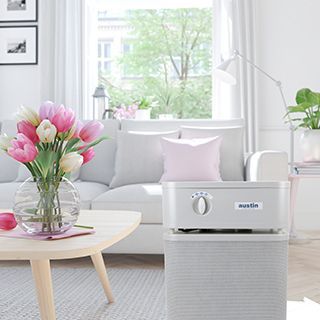The need for air purifiers has grown exponentially over the last few years, but as demand increases, so do the number of questions and concerns. So, this week we take a look at some of those issues and try to clear up any misconceptions that may be floating around.
MISCONCEPTION: Air Purifiers Are Not Effective as They Don’t Use ‘Fresh’ Air from Outside
TRUTH: The main thing to consider here is our definition of ‘fresh’ air. Outdoor air, that’s air from the street, is often far from ‘fresh.’ According to the EPA (1), the most common contaminants found in outdoor air are carbon monoxide, lead, nitrogen dioxide, ozone, particulate matter, and sulfur dioxide.
So yes, it is true, portable HEPA air purifiers do not use outdoor air, but we see this as a positive. Austin Air purifiers only deliver clean air, free from contaminants. So when the air in a room is cleaned using an Austin, air quality will be far higher than opening a window to let in the ‘fresh’ air.
MISCONCEPTION: Air Purifiers Don’t Work in Big Spaces Such as Classrooms
TRUTH: When selecting an air purifier, it is important to check it will be adequate for the space required. Many air purifiers are designed for small rooms, but this is not the case with an Austin. The unique design of our units ensures the clean, filtered air is pushed back into the room via a directional export vent. This guarantees the entire room is free from pollutants, not just the air directly around the unit. It is this ability to create air circulation in a room, together with an unrivaled filter capacity that provides exceptional cleaning, even in large spaces.
MISCONCEPTION: Air Purifiers Trap COVID-19 But Will Release It Again Later, Risking Recontamination.
TRUTH: Our air purifiers are designed to pull contaminants into the unit, where they pass through a 4 or 5 stage filtration system, comprising a pre-filter, a medium filter, a HEPA filter, a carbon filter, and a HEGA carbon cloth. The medium-sized filter, together with the HEPA, the HEGA, and the carbon filter, are sealed into a one-way system. Once pollutants are captured, they are trapped in the filter, with nowhere to go. This applies to COVID-19, mold spores, allergens, and any other pollutants inside the filter.
MISCONCEPTION: HEPA Only Traps Particles That Are 0.3 Microns; COVID-19 Is Too Small to Be Trapped.
TRUTH: While it is true that Medical Grade HEPA is certified to remove particles that are 0.3 microns and larger, this does not mean HEPA is ineffective at capturing smaller particles. It may come as a surprise, but particles that are 0.3 microns in size are more difficult to capture than smaller particles, which is why this particle size is used in the certification. Smaller particles, such as COVID-19, are easier to catch due to a process known as ‘Brownian Motion.’ Smaller particles, flow in a zig-zag motion, making it easier for them to be captured by the HEPA filter.
MISCONCEPTION: Air Purifiers Require Regular Filter Changes Which Can Be Costly
TRUTH: There are several air purifiers on the market that require regular filter changes, some as often as every few months. To avoid this extra expense, here at Austin, we use unrivaled amounts of HEPA and carbon in our filters to ensure a long filter life of up to five years.
MISCONCEPTION: Air Purifiers Produce Ozone
TRUTH: Since the arrival of COVID-19, a number of electronic or ionizer air cleaners are being promoted as a solution for the removal of viral particles from the air. However, this type of technology does not remove pollutants from the air, they create particles charged with electricity, that attach themselves to pollution particles. Once attached, particles fall to the ground, where they can later be swept up. However, independent studies (2) show electronic air cleaning devices can produce dangerous levels of chemicals, either directly or as a by-product of chemical reactions.
This is why the WHO (3), the CDC (4) and members of the scientific community (5) recommend using HEPA air purifiers as a safe and effective way to improve air quality and reduce the risk of COVID-19 transmission.
Hopefully, this article has helped to explain some of the misconceptions around air purifiers, but if you have any further questions or concerns, please don’t hesitate to contact one of the team at info@austinair.com. We’re always happy to help.
And if you would like further info on our products and what they can do for you, please click HERE.
References
(1) Outdoor Air Quality | US EPA
(3) 9789240021280-eng.pdf (who.int)
